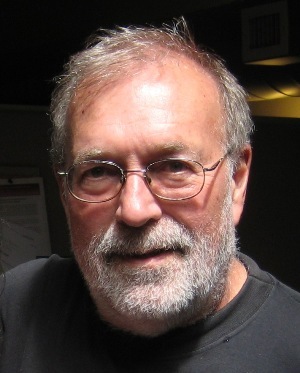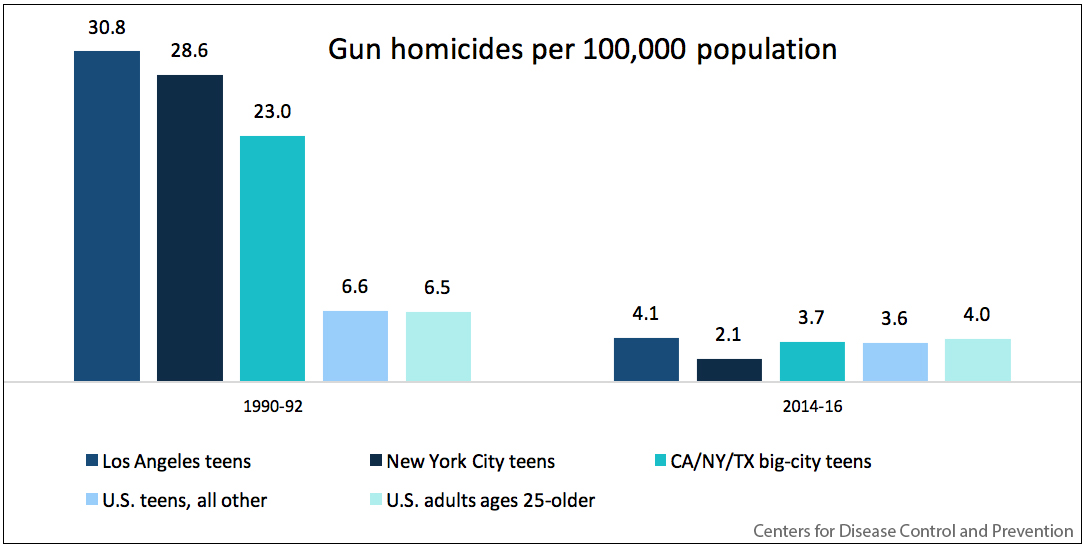Over the last 25 years, the big cities in California, New York and Texas gained 1.1 million Latino and Asian teenagers, swelling their teen populations to five million (one in eight 10- to 19-year-olds in the United States).
Here are the accompanying trends in gun homicide death rates among teenagers comparing 2014-16 with 1990-92:
- New York City: 93 percent decrease
- San Diego: 89 percent decrease
- Los Angeles: 87 percent decrease
- Dallas/Fort Worth: 83 percent decrease
- El Paso, Texas: 81 percent decrease
- Austin/San Antonio: 72 percent decrease
- Houston: 65 percent decrease
- San Francisco/Oakland/San Jose: 52 percent decrease

Mike Males
In Los Angeles in 1990, 251 youths were arrested for murder. In 2016, just eight. In New York City in 2016 and 2017, teens under age 20 had fewer homicide deaths and arrests than adults age 50-59.
In Dallas, Fort Worth and Austin, the teenage population exploded by 300,000 with significant increases in its proportion of Latino teenagers over the last generation. Meanwhile, their gun killings fell by 83 percent.
Teens are safer, less dangerous
Whether marching against gun violence or actually reducing gun killings, today’s new teenager is nothing like the crime-prone “teenager” of popular stereotype.
Today, these big-state, big-city teenagers — three in four of whom are nonwhite, the ones experts once branded “juvenile super-predators” — are substantially less at risk of being murdered by guns than America’s allegedly brain-matured adults 25 and older.
We liberals celebrate, and conservatives berate, the thousands of marchers led by suburban Parkland, Florida’s high school massacre survivors who are pushing tougher gun controls. All sides ignore the massive declines in actual gun killings among what used to be our most endangered youth.
Plummeting gun violence among diverse urban teens doesn’t fit crime experts’ predictions, academics’ theories, politicians’ ideologies or interest groups’ lobbying needs. We’re threatened by change (unless we’re trying to take credit for it) — even hopeful change with vital lessons.
We deserve no credit for the fact that, over the last generation, teenagers decided to act much, much better across many dimensions (guns, crime, school dropout, unplanned pregnancy, etc.) exactly where we expected it least.
EPA regulations may be factor
We’ve done nothing to relieve devastating urban youth poverty even though we know poorer populations suffer disproportionately and unnecessarily, especially from gun killings. We ignore adult-perpetrated domestic violence victimizing hundreds of thousands of children and teenagers every year.
We’ve done little about guns but squabble. Yet, gun violence among teenagers plummeted in New York and California (which have among the nation’s strongest gun controls) and Texas (which has among the weakest).

Things are better in one respect: environmental regulations have sharply reduced neurotoxins like lead that foster anti-social behaviors (interestingly, the same ones obsolete stereotypes claim are innate to teenagers). Along with immigration, the Environmental Protection Agency might be a big crime-buster.
Despite this, we elders (against the will of young voters) elected a Republican administration dedicated to demolishing EPA rules and attacking young immigrants. Instead of sober assessment and action, we indulge silliness: Video games, rap songs and the risky “teenage brain” (which has been debunked by neuroscience reviews and crime trends) are all claimed to be at fault for youth behavior.
We in the justice system see only the tiny fraction of teens who get arrested, not the rising majority who avoid trouble. We have no business disparaging teenagers as brain-wired to commit crime. We can’t explain higher arrest rates among ages 30-39, 40-49 and (in California) 50-59 — including for “dumb crimes” like low-level drug/alcohol, property and assault offenses — than among high-school ages.
Student spokespersons seem to be discovering the grotesque lies and omissions paralyzing the American gun debate. Children and youth are far more in danger of mass shootings at home perpetrated by adults than at school by peers. In the past year, 30 gun-homicide tragedies occurred in schools whereas 14,500 gun-homicides occurred at homes, workplaces, businesses and streets. Even after Parkland, schools remain far safer from gun violence than these other frequented spaces.
No matter how dramatically adolescent behavior changes, we cling to the same old popular stereotypes of reckless teens menacing dangerous schools and streets. Perhaps we adults just aren’t up to the challenge of dealing with modern change. In that case, bring on the new kids.
Mike Males is senior research fellow for the Center on Juvenile and Criminal Justice in San Francisco. He is author of “Teenage Sex and Pregnancy: Modern Myths, Unsexy Realities.”

Food for thought – it is worth taking a look at the decrease in child abuse 15 years or so ago also.